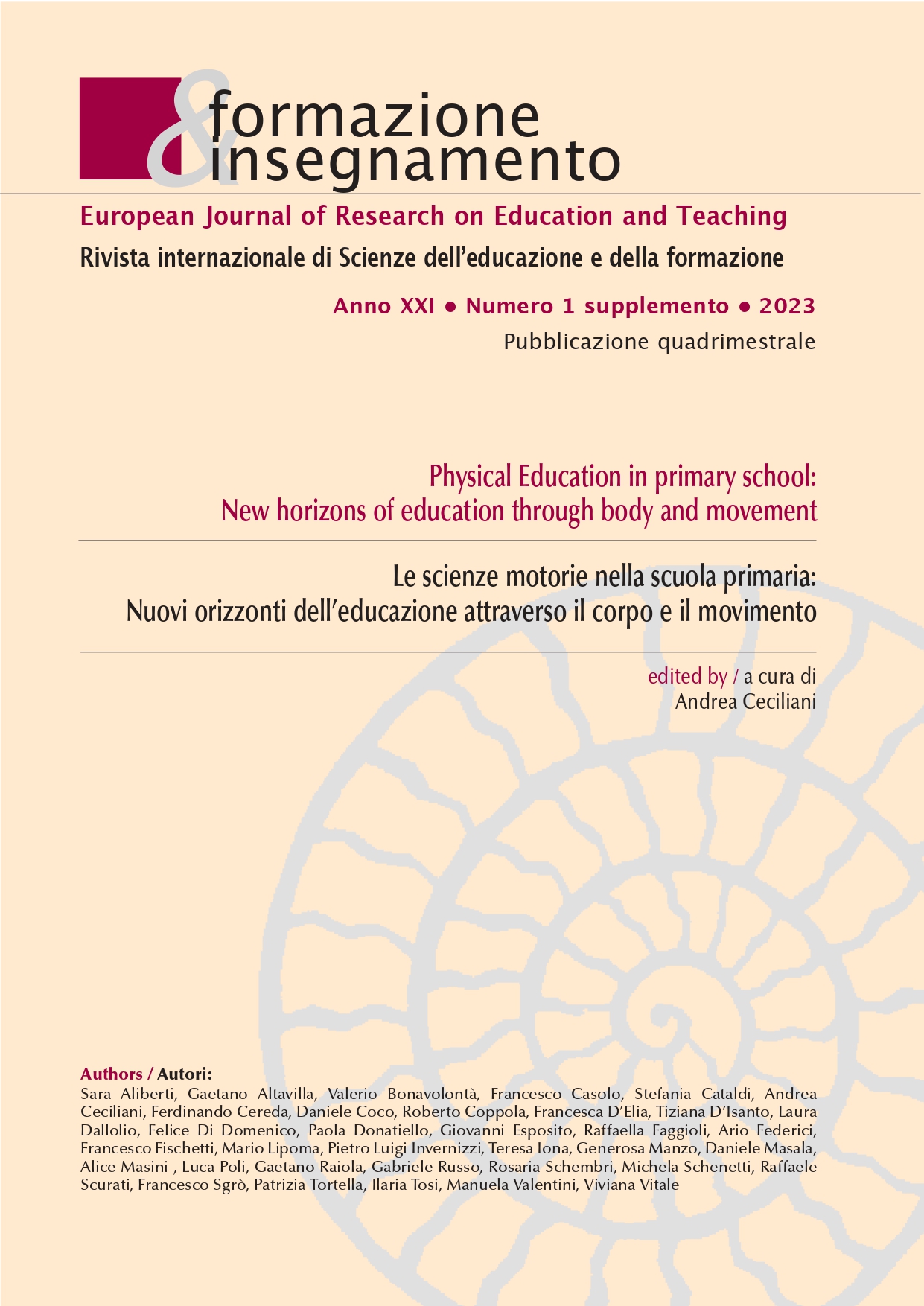‘Elementally’ in motion
DOI:
https://doi.org/10.7346/-feis-XXI-01-23_02Palavras-chave:
Outdoor education, Integrated curriculum, Motricity, COVID-19, CorporealityResumo
The new social orientation tends to isolate, within technological networks, social actors who increasingly adapt to an unnatural and myopic sedentarism. The COVID-19 pandemic has accentuated the needs of everyone, especially of children, who have been excluded from the pro-social and environmental dynamic environment. The aim of this essay is to reflect on the opportunities opened by the crisis understood as "decisive phase", from the Greek krísis "choice, decision". It is time to take action and ride the wave og change in order to approach new integrated educational models that can focus on the potential of motor skills, especially outdoors, related to learning, cognitive, emotional and physical improvement. The body, acted and primary learning agent, is necessarily in motion, involuntarily and ineluctably in an incessant search and discovery of Self, a Self placed in relation to the world and to the Others.
Referências
(the) Annie E. Casey Foundation (2021). 2021 Kids Count Data Book: 2021 State Trends in Child Well-being. The Annie E. Casey Foundation. Retrieved January 31, 2023, from https://www.aecf.org/resources/2021-kids-count-data-book
Borghi, B. Q. (2015). La lezione di Maria Montessori: una scommessa per il futuro. In M. Baldacci, F. Frabboni, & M. Zabalza (Eds.), Maria Montessori e la scuola d’infanzia a nuovo indirizzo (pp. 47–56). Bergamo: Zeroseiup.
Cocever E., & Canevaro A. (2011). Introduzione. In A. Vasquez, & F. Oury (Eds.), L’organizzazione della classe inclusiva. La pedagogia istituzionale per un ambiente educativo aperto ed efficace (pp. 1–13). Trento: Erickson.
Coyle, K. J. (2017). Digital Technology’s Role in Connecting Children and Adults to Nature and the Outdoors. Virginia: National Wildlife Federation. Retrieved January 31, 2023, from https://www.nwf.org/~/media/PDFs/Kids-and-Nature/NWF_Role-of-Technology-in-Connecting-Kids-to-Nature_6-30_lsh.ashx
Cooper, A. (2015). Nature and the Outdoor Learning Environment:The Forgotten Resource in Early Childhood Education. International Journal of Early Childhood Environmental Education, 3(1), 85–97. Retrieved January 31, 2023, from https://eric.ed.gov/?id=EJ1108430
Dewey, J. (2004). Democrazia e educazione. Milano: Sansoni.
Farné, R., & Agostini, F. (2014). Outdoor education. L'educazione si-cura all'aperto. Bergamo: Edizioni Junior-Spaggiari.
Federici, A. (1993). Attività motorie in ambiente naturale. Idee, proposte ed esperienze. Urbino: Montefeltro.
Federici, A. (2015). Attività motoria in ambiente naturale: una scelta per la vita. RELAdEi, 4(3), 103–115.
Federici, L. (2022). Il videogioco nell’educazione 4.0: così il gaming forma, educa e istruisce. Gaming a scuola. Agenda digitale, 11 Mar 2022. Retrieved January 31, 2023, from https://www.agendadigitale.eu/cultura-digitale/il-videogioco-nelleducazione-4-0-cosi-forma-educa-e-istruisce/
Floridi, L. (2020). Il verde e il blu. Milano: Raffaello Cortina Editore.
Freire, P. (2017). Le virtù dell’educatore. Milano: EDP.
Galeri, P. (Ed.). (2009). Ambientando. Riflessione pedagogica ed esperienze didattiche per l’ambiente. Milano: EDUCatt.
Moliterni, P. (2014). BES e progettazione inclusiva. In P. Gaspari (Ed.), Pedagogia speciale e “BES”. Spunti per una riflessione critica verso la scuola inclusiva (pp. 95–121). Milano: FrancoAngeli.
Guerra, M. (Ed.). (2015). Fuori. Suggestioni nell’incontro tra educazione e natura. Milano: FrancoAngeli.
Le Boulch, J. (1971). Verso una scienza del movimento umano. Roma: Armando.
Lodi, M. (1972). Cipì. Torino: Einaudi.
Lodi, M. (1977). Cominciare dal bambino. Torino: Einaudi.
Lodi, M. (1982). Guida al mestiere di maestro. Roma: Editori Riuniti.
Malaguti, E. (2011). Donne e Uomini con disabilità. Studi di genere, disability studies e nuovi intrecci contemporanei. Ricerche di Pedagogia e Didattica, 6, 1. https://doi.org/10.6092/issn.1970-2221/2238
Malaguzzi, L. (2010). I cento linguaggi dei bambini. L’approccio di Reggio Emilia all’educazione dell’infanzia. Bergamo: Edizioni Junior.
MIUR. (2012). Indicazioni nazionali per il curricolo della scuola dell’infanzia e del primo ciclo d’istruzione. Annali della pubblica istruzione, 88, 3–82. Retreived January 31, 2023, from http://www.comune.torino.it/centromultimediale/01c_I_documenti_pedagogici/documenti_Nazionali_pdf/2012_Indicazioni_Curricolo_Sc_Inf.pdf
Montessori, M. (1950). La scoperta del bambino. Milano: Garzanti.
Mulato, R., & Riegger, S. (2014). Maestra facciamo una pausa?. Bari: La Meridiana.
Okur-Berberoglu, E. (2021). Some Effects of Unstructured Outdoor Plays on a Child: A Case Study from New Zealand. International Electronic Journal of Environmental Education. 11(1), 58–78. Retrieved January 31, 2023, from https://eric.ed.gov/?id=EJ1281430
Scaparro, F. (2002). La famiglia allungata, giovani e sicurezze apparenti. Corriere della sera, 6 aprile, p. 1.
Schwartz, B. (1995). Modernizzare senza escludere. Un progetto di formazione contro l’emarginazione sociale e professionale. Roma: Anicia.
Valentini, M., & Pellegrini, T. (2019). Active video games (AVGS) during childhood: role of the exergames and their impact on physical activity. In M. Lipoma (Ed.), La società per la società: ricerca, scenari, emergenze sull’educazione motoria e sportiva. Lecce: Pensa MultiMedia.
Wenger, E. (2006). Comunità di pratica: Apprendimento, significato e identità. Milano: Raffaello Cortina.
Zhang, T., Moore, W., Gu, X., Chu, T. L., & Gao, Z. (2016). Promoting Children’s Physical Activity. Physical Education: The Role of Active Video Gaming. JTRM in Kinesiology, Jan 2016, 1–13. Retrieved January 31, 2023, from https://eric.ed.gov/?id=EJ1088275
Zhang, T., & Lee, J. (2020). Developing a Motivationally-Supportive Environment to Promote Children’ Physical Activity and Health in Youth Sports During the COVID-19 Pandemic. JTRM in Kinesiology. Sep 2020, 22–24. Retrieved January 31, 2023, from https://eric.ed.gov/?id=EJ1272713
Downloads
Publicado
Como Citar
Edição
Seção
Licença
Copyright (c) 2023 Manuela Valentini, Paola Donatiello

Este trabalho está licenciado sob uma licença Creative Commons Attribution 4.0 International License.
Formazione & insegnamento é distribuído sob a Attribution 4.0 International (CC BY 4.0).
Para obter mais detalhes, consulte nossa Política de Repositório e Arquivamento, bem como nossos Termos de Direitos Autorais e Licenciamento.





